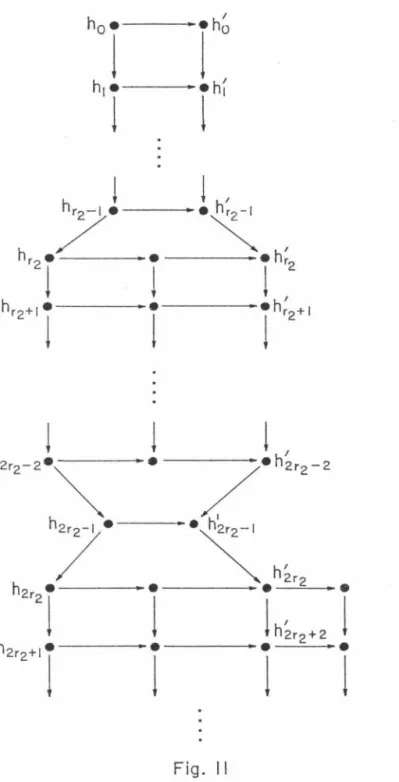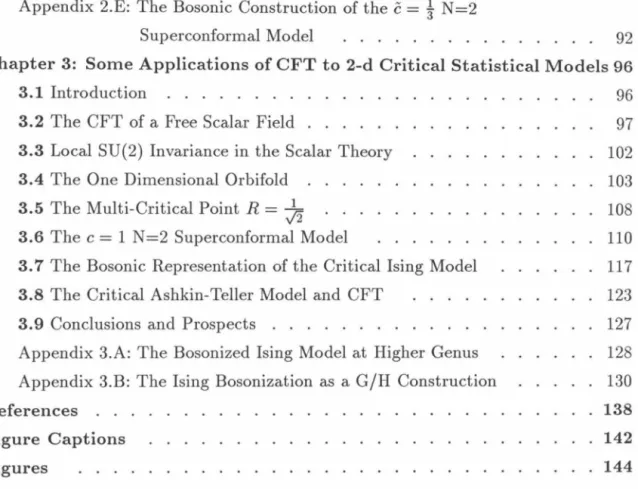7 The Bosonic representation of the Critical Ising Model 3.8 The Critical Ashkin-Teller Model and CFT. It is an object that can be defined for each representation of the conformal group.

CHAPTER 2
Introduction
The first step in the study of N =2 theories is to calculate the determinant Kac. The first consists in defining, (using the Kac determinant), the pattern of embedding representations in the original one.
Modular Invariance, Characters and Partition Functions on the Torus
Thus, knowledge of the signs and representational content of the theory is sufficient to determine the partition function. As already mentioned, the characters of the representation can be calculated by purely algebraic means.
Character Formulae and the Structure of the Representations of the N=2 Superconformal Algebras
In the next section, we will analyze the structure of the representations of N =2 superconformal algebras, and we will finally evaluate their characters. For all the other allowed values of q, the nesting pattern is that of Fig. From the structure of the representations of N S3, we can conclude that their grades are given by (2.3.39).
These representations are important in the construction of the four generators of the four-dimensional N = 1 supersymmetry. In this case we have two different supersymmetry generators (supercharges), as well as a 0(2) (or U(1)) current that manifests the symmetry of the theory under a 0(2) rotation of the two supersymmetries. The natural space to define the fields of the theory is N =2 superspace, (or more precisely (2,0) superspace).
The vacuum state belongs to the N S sector and is the basic state of the theory. On the other hand, if such a condition does not exist in theory, a supersymmetry of both is broken. In fact, this condition will generate limitations in the correlation functions, of the primary state 1.6., Q}.
In fact we will show that the operator algebra of unique degenerate representations of theN = 2. For the twisted sector we need the correlation functions of the disorder fields C which are currently unknown.
APPENDIX 2.A
Then g~~ = 2h - q, so a state with h = q/2 is an example of a primary state that generates such a representation. It is obvious that this null vector does not generate a full Verma module since it is annihilated by G_1; 2. At higher levels, the degenerate modes also involve generators of the Virasoro or U(1) algebra.
For example, at no = ±3 /2, the corresponding states are,. 2.A.4b) Again, these null hwvs do not generate full Verma modules. There are lowering operators that destroy them. ii) R± algebra, zero states with the same charge as initial hwv. When h = ~' one of the two states of opposite parity is degenerate at level zero and decouples from the spectrum.
The existence of the state with h = ~ implies the non-vanishing of the Witten index and thus that supersymmetry is continuous in the cylinder. 2.A.16b). The examples presented above are also very important in deriving the super-differential equations satisfied by the correlation functions of the corresponding degenerate hwvs.
APPENDIX 2.B
To evaluate the commutators of wJo with the supercharge operators we have to consider:. Some special examples in this case are the incomplete Verma modules generated by the zero vectors of the degenerate representations of the NS and R± algebras with . To motivate the discussion, let us look at the simplest example of such a module generated by null hwv at level 1/2, (no = 1/2), of the N S algebra, given explicitly.
So in our previous calculation of the partition functions, ground states with a G _1/ 2 operator do not contribute. For a zero-hwv at some level lnol, (none is an integer or a half-integer, corresponding to R± or NS, respectively), the partition function lacks the contribution of G-no• sgn(no) > 0 or G-n0, sgn (no) < 0.
APPENDIX 2.C
APPENDIX 2.D
Consequently, the conditions derived from the three-point function are those of relative change 1 with the additional substitution Qi-+ -Qi, Aij-+ -Aij·.
APPENDIX 2.E
Introduction
Conformal field theory is a very promising approach to obtain an exact solution for well-known 2-d critical statistical patterns, or to find broader classes of patterns not previously recognized. There are many CFT models that describe well-known classes of universality of critical behavior in 2-d. Unitary models with c < 1 are known to describe the critical behavior of an infinite series of models introduced by Andrews, Baxter and Forrester, [34].
The solution of the modular invariance constraints shows that there are two consistent subsets of operators for c = t. One of these describes the tri-state model (Z3), Potts model, [36], while the other describes the. All critical lines of the Askin-Teller model (A-T) have been described using conformal field theory. The critical behavior of isotropic spin-s antiferromagnetic chains is described by the SU(2) WZW model with central charge k = 2s, [40).
A completely new class of SU(N) ® SU(N)f SU(N) RSOS models has a critical behavior described by the corresponding G/H CFT [41].
As can be seen from (3.2.3), the field ¢> is not a good conformal field (its correlation functions grow with distance). Among the operators that can be constructed from polynomials in ¢> and derivatives, the only primary conformal field is Bz¢>. There is also a right-handed flow, Bz¢>, which generates U(1)R· There are two additional symmetries Zz,.
The disturbance created by such operators can be written as an additional term in the action. To preserve criticality, the dimension of the boundary operator must not change under the perturbation. Thus, the neighborhood of the CFT can be parameterized by couplings of 9i edge operators.
There is usually an enhanced symmetry at such points associated with some of the marginal perturbations. The perturbation it causes changes the action from,. which constitutes a change in the radius of compactness: fixation by 8R2 = 8gR2. This can be easily seen from the division function, . 3.2.24) Correlation functions and operator products are invariant under duality.
Local SU(2) Invariance in the Scalar Theory
But in order for marginal operators to remain marginal under perturbation, we end up with only two possible candidates, the self-dual point R = .J2 and the point R = -k. But due to SU(2) invariance they are equivalent to each other and in particular to J3 J3 = OzOz.
The One Dimensional Orbifold
Something worth noting is that the dimensions of the primary states in the twisted sector do not depend on the radius of the orbifold. In the non-rotated part of the spectrum, the transformation is the same as in the torus model, (3.2.24). Thus, the analysis of the existence of multicritical points is the same as in torus models.
In the NS sector of the model, the dimensions of the primary superfields N=1 are 1, i and /6. If ~ is the dimension of the bosonic component g(z), then the corresponding dimension for the fermionic partner is ¢( z) ~ + t. It was shown in Appendix 2.C that a single twisted sector operator c.
Because the operator in the T sector twists one of the two bosonic components of the N = 2. Thus we identify the dimension /6 operator in the NS sector with one of the twist fields, H0. The distribution function of the bosonic theory is thus given by the sum over the various sectors.
The Critical Ashkin-Teller Model and CFT
Finally, the partition function of the orbifold model at R = 1 is easily shown to be the square of the partition function of the Ising model. 3.8.4) where the chain has N sites, e is a coupling constant, .X plays the role of the inverse temperature and. On the other side of the c = 1 line ending in the Kostelritz-Thouless point, start two lines defining a.
For most of the rest we will focus on the c=1 line as well as the two Ising lines. This in fact together with the modular invariance rules the partition function of the A-T model to be the orbifold partition function (3.5.5). Our analysis predicts the existence and value of the second magnetic exponent x H = ~ corresponding to the presence of the family [196, 1.
Indeed, the renormalization group analysis of [52] derived the form of the Hamiltonian for these lines. 7 actually gives the correct mapping between the bosonic variables of the A-T model and the nature of Ising critical lines. The critical points of the A-T model have phenomenological significance as they seem to describe the superfluid-to-normal transition of H e4 films, [55] and possibly the critical behavior in planar magnets, [56] and liquid crystals, [ 57].
APPENDIX 3.A
Note that (T(z))p depends on z, since translation invariance is not a symmetry of the correlation functions for g > 1.
APPENDIX 3.B
We will now use the fact that the SU(2) Kac-Moody algebra at level one can be constructed from a free boson with radius R = V2*. The Sugawara stress-energy tensor is just the sum of the stress-energy tensors of the two bosons. We can now use can use (3.B.3) to compute the stress-energy tensor for the subalgebra. 3.B.8) We will use the second basis for bosons such that the formulas become
Then (3.B.13) and (3.B.ll) is written in terms of the PI boson and the fermion in its bosonized form in terms of P2· The same remarks apply to the decomposition of SU(2)I ® SU. (2) Representations in representation of SU(2)2 ®Ising. The reason for the appearance of the roots of SU(N) is the fact that the SU(2)N prefermions can also be constructed as a coset space SU(N)I ® SU(N)l/SU(N)2. The spin fields of parafermionic theory are torsion fields for vertex operators 1/J±l· The fact that ak turns 1/J±I with ± t completely defines the correlation function,.
The above procedure for modifying the stress energy tensor with (2,0) operators is not limited to G/H theories. For T(z) to have the properties of a stress energy tensor as in (1.1.21b), the coefficients must satisfy the following equations. Fig.1 Embedding diagram for the degenerate representations of N=1 unitary minimal models and for Two representations of the N =2 algebra.

